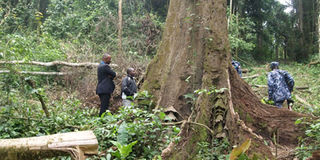Masindi loses 42 forests in 9 years

Effect. Nema officials inspect a section of the degraded Bugoma forest in Hoima District last year. Leaders in neighbouring Masindi District have embarked on replanting the 42 degraded forests. PHOTO BY EPHRAIM KASOZI
What you need to know:
According to the 2009 National Environmental Management Authority (Nema) report, Uganda had more than five million hectares of forest cover in 1990. According to the 2009 National Environmental Management Authority report, Uganda had more than five million hectares of forest cover in 1990. But by 2005, only 3.5 million hectares (8.6 million acres) remained.
MASINDI. Leaders in Masindi have embarked on replanting 42 forests cut down by charcoal and timber dealers in the last nine years.
The district assistant forestry officer, Mr Anthony Akok, said of the 62 forests that existed by 2010, only 20 forests still stand.
“We can only find 20 forests although they are also being encroached on by some people but we cannot trace the 42 because they were cleared to zero,” Mr Akok said on Tuesday.
“About 80 per cent of the exploited forests is done by timber dealers and settlement by the farmers,” he added.
The district secretary for production and natural resources, Mr Titus Ariyo, said they will reclaim all the land of the degraded forests and allocate a third of it to tree farming.
Mr Ariyo added that the district administration will soon pass a by-law that prohibits all charcoal dealers from using vehicles as a form of transport to avoid cutting many trees.
“Those dealing in charcoal are strictly supposed to use bicycles as means of transport so that they don’t carry more than one sack,” he said.
The degraded forests include Kaitampisi, Kyamasuka, Bineneza and Ntuuma.
“We are aware of those forests and they are on the plan to be replanted soon,” Mr Asiku said.
The district administration has also embarked on securing land titles for Tengele, Motokaalimugonza, Kaitampisi, Kyamasuuka and Bineneza forests to protect them from encroachment.
Legislation
The district environmental officer, Mr Nsimire William, said the degradation has been escalated by the absence of the district environmental action plan and failure to implement the natural resource ordinance, which mandates residents to commit 10 per cent of their land for tree planting. “We have failed to implement the ordinance and people have used that as an advantage to clear our forests,” he said.
“The problem is that these farmers clear forests and plant rice for sale, which is happening in most degraded forest land,” Mr Nsimire added.
In 2016, Bunyoro Kingdom gave out 8,000 hectares of Bugoma Central Forest Reserve to a sugarcane company for sugarcane growing something that angered environmentalists.
Mr Micah Asiku, the executive director of Ecotrust Uganda, a non-governmental environmental conservation organisation, said 200,000 hectares of forests across the country are depleted annually for agriculture and lumbering, which he said leaves Uganda in danger of being a desert soon.
“We have forest cover of just 9 per cent from 23 per cent in 2015. We are at a risk of missing rains and becoming a desert country,” Mr Asiku said.
In November last year, the ministry of Environment announced plans to demarcate all forest boundaries and introduce management plans for all forests in the country. “We heard of that plan by government and we don’t know where they have reached because they have not communicated back,” Mr Asiku added.
[email protected]




